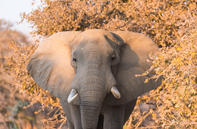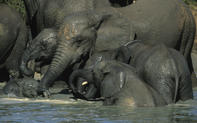Multifunctional Ears
The ears of an African elephant are enormous with a bull elephant having ears two metres by 1.2 metres in extent and 20 kg in weight each. These have multiple uses.

They are used for hearing with the large area acting like a satellite dish to channel sounds into the eardrum the opening of which is in front of the flap. They also play a vital role in thermoregulation, heat control, effectively dissipating three-quarters of the heat needed to maintain a constant body temperature.
The ears comprise 20% of the elephant’s entire surface area and the otherwise thick skin of the elephant is thinnest over the ears and well supplied with blood capillaries that run close to the surface. An elephant can pump all of its blood through its ears every 20 minutes (up to 12 litres a minute) and by flapping the ears or spraying dust, mud or water behind them, this cools the blood in the capillaries, which then flows back into the body.
On cooler days, elephants hold their ears close to their bodies conserving the heat in the capillaries, which has the opposite effect. Elephant ears are also used to express mood during social interactions.
Bath Time

Elephants are especially partial to bathing and swimming during which time they will either spray themselves down or submerge completely using their trunks as snorkels. Bulls especially are playful during swimming time and they engage in social dominance contests and play fighting while in the water.
Bathing also helps to cool their large thick-skinned bodies down. Mud-wallowing or dust-bathing is another form of thermoregulatory exercise used by elephants. Applying a layer or moisture or dust to the sweat gland-free skin traps a layer of cooler air close to the skin and also prevents excessive exposure of the skin to the sun.
Once the mud dries elephants will rub against hard objects like rocks or tree trunks to remove the itchy pieces. In the process they also work free parasites entombed in the dried mud. An elephant’s habit of wallowing in mud has the ecological repercussion of creating or broadening depressions in the ground which subsequently form pans that hold rainwater that can be used by other species.
By Megan Emmett